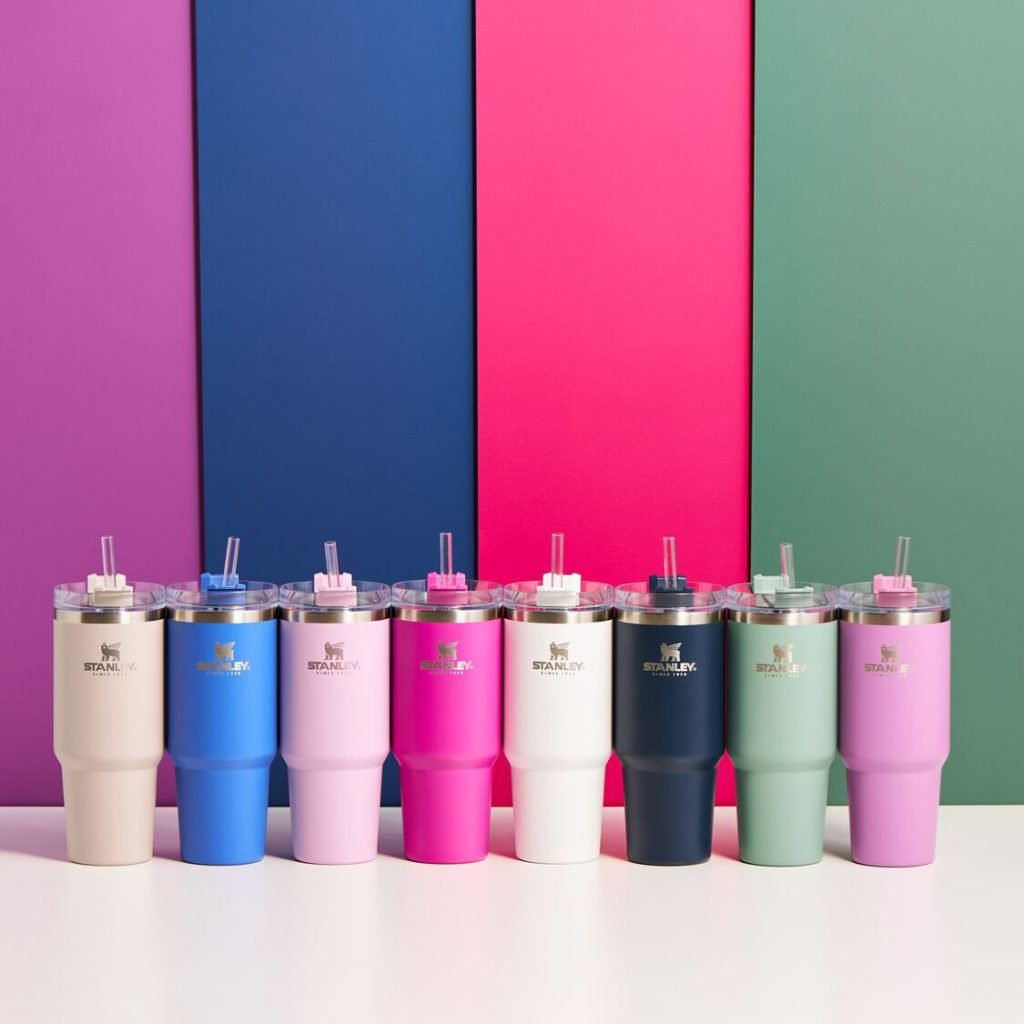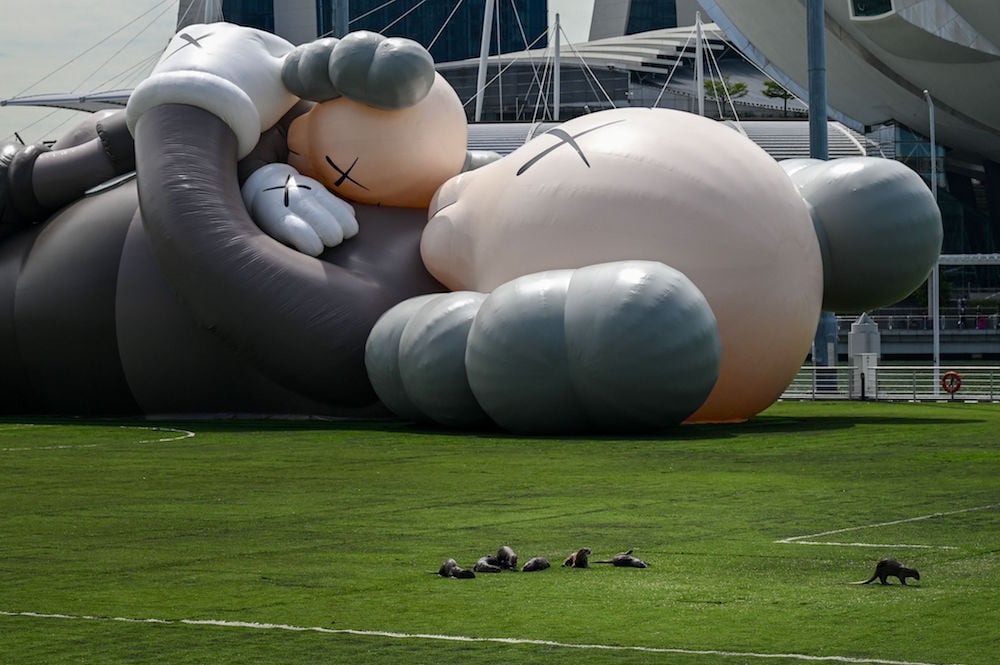Opinion
The Stan Culture for Stanley Quenchers Has Some Pretty Cringey Parallels With the Art World
An overwhelming cornucopia of colorful choice, molded around scarcity, is a desire machine that we all know well.

An overwhelming cornucopia of colorful choice, molded around scarcity, is a desire machine that we all know well.

Kate Brown

Like many of you, Stanley Quenchers blipped onto my radar sometime in December. My friend in New York called as she was chasing around Brooklyn in a panic, trying to land one of these mugs for her 9-year-old daughter. Then the TikTok videos arrived into my feed, bodies racing past one another to grab mugs in deep magenta at a single shelf in a fluorescent-lit store.
While fanaticism over goods is nothing new or remarkable, the case of the current craze for the Stanley Quencher—which, in case you missed it, is a $45 large sippy cup for adults—reminds me of the art world and its system for establishing hype by creating an overwhelming cornucopia of colorful choice molded around scarcity. This creeping wash of pastels and soothing imagery (like much of the Stanley social media content) was everywhere at fairs last year—the dominant mood a projection of the pretty, the cute, and the interesting, a weirdly cozy phase of late capitalism.
No matter what price point we are buying in, collectordom relies on the thrill of the chase, the dopamine rush that comes with the success of the find, and, ultimately, the customizability of a personal collection as a way to adorn one’s identity. The quencher craze, as such, even has its own secondary market; and Stanley president, Terrence Reilly, has been talking in his media tours about wait lists.
Quenchers have helped Stanley, an outdoorsy company that used to market to blue-collar workers and camping dads, skyrocket in profits—they made $750 million last year compared to an average of $70 million in 2020. Its new army of followers seem to be aware of the nature of their crazed pursuit, poking fun of themselves in videos while promoting their cups. Some mock the mugs’ social media-famous status; One of the highlight TikTok videos circulating shows a woman reaching into her burned out car to fetch her quencher from its charred mug holder. “It’s still got ice in it!” is the takeaway. A man waddles around with a garbage bin that he has retrofitted with a crafted extra large straw.
One could take similar jabs at so much of what grabs art world headlines—KAWS’s serial and gigantic Companions, which seem to grow in mass each time they appear around the world in a joking array of derivatives. My colleague texted me a snap in the fall of Jade Fadojutimi’s ever-larger canvases that engulfed the wall of a fair booth—they keep getting bigger, not better. How different is that instantly recognizable Alex Israel sky painting, and the way it communicates with those who see it as something about the person who owns it, from a mug in similar gradients of pink and blue?
And though, quite obviously, the process of making and selling paintings, sculptures, or NFTs, is more bespoke and thoughtful for the most part than production-line goods, all are bound together by the same conditions of the internet, human psychology, and attention economies.
“I first got into Stanleys through my younger sister. She’s a big collector,” 30-year-old Destinee told Dazed last week. This interviewee had spent about $300 on her “collection” of reusable mugs; others interviewed have spent upwards of thousands of dollars. For some people, that is a lot of money. “Owning a Quencher means becoming part of a community,” Guardian reporters recently evaluated; it is a quote that echoes what a Damien Hirst NFT collector told my colleague at his recent artwork-burning event (speaking of social media circuses, you can read about that here): “I see the NFT more as an access card to the Damien Hirst club.”

Damien Hirst (2022). Photo by Jeff Spicer / Getty Images.
For a practical and rather pedestrian object to be so coveted that it recirculates at higher prices margins, it needs to have undergone the magical process of signifying something more than just reusable water bottles. There is something artistic and mystical about that process an object transcends into in these scenarios—key to the equation are values and membership. Similarly, when a smallish painting is for sale, we often hear quick pitches on an artist that are packed with the buzzwords of the moment. Stanley cups are reusable, and a collection, therefore, ethical (how far from true), which instrumentalizes a similar logic to lend symbolic value. But, just like collectors stockpiling art that won’t fit on their walls in storages, the craze reaches a point of diminishing returns on that value system that you bought into in the first place.
Drink in eight new 40 oz Quencher H2.0 colors and designs made just for @target.
Shop now in Target stores and online: https://t.co/fZkHNzkHf6 pic.twitter.com/nGaqYteMHP— Stanley 1913 (@StanleyBrand) March 12, 2023
I am being a bit unfair to the art world. Much of what we see, think, and comment on is mind-broadening and visually challenging—on the whole much more world-building stuff compared to the conversation around heat-retaining cups. A lot of it is not. And so, we cannot ignore what kinds of desire cycles we run in, if only to remain reasonable about how much the art industry can and should see itself as more profoundly important than any other. In other words, we would be lying to ourselves to pretend a major artery of the art business does not rely on and feed into the exact same attention economies that Stanley (and a bunch of other brands, like the lingerie brand Skims, for that matter) have plugged into their business calculus: rarified goods stoking demand, seasonal production cycles creating derivatives that seem new, and, of course, the key one, symbols of status and membership.

A family of smooth-coated otters are seen next to the “KAWS:HOLIDAY” art installation featuring the “COMPANION” figure. Photo by Roslan Rahman/AFP via Getty Images.
We like to think our flows of desire and transactions mean more than the short-lived craze of the current quencher moment. But that echoes with other patterns of dismissiveness we have seen even from within the field: the shrugging off of NFTs, the tut-tutting of luxury collector culture as something other than what the art market is.
I guess what I am asking is that we aim to actually do better. Aesthetics can offer a bit of escapism in a world that is generally feeling pretty bad. My friend in New York needed not just any cup but a melon-hued one. I was reminded of Pantone’s “peach fuzz” hue of the year, a hue all about “empathy” and “human connection.” As the world continues to become increasingly difficult to parse, our online sphere—the place where see most of that which we desire, be it art, fashion, or cups, tries to give us a counterpoint for the dystopia outside, tracking more and more towards whimsy jelly bean color schemes.
More Trending Stories:
Art Dealers Christina and Emmanuel Di Donna on Their Special Holiday Rituals
Stefanie Heinze Paints Richly Ambiguous Worlds. Collectors Are Obsessed
Inspector Schachter Uncovers Allegations Regarding the Latest Art World Scandal—And It’s a Doozy
Archaeologists Call Foul on the Purported Discovery of a 27,000-Year-Old Pyramid
The Sprawling Legal Dispute Between Yves Bouvier and Dmitry Rybolovlev Is Finally Over